Physical Address
304 North Cardinal St.
Dorchester Center, MA 02124
Contamination of health care workers (HCWs) with body fluids is a frequent occurrence in the emergency department (ED). A survey of ED and trauma staff found that almost half reported a needlestick injury within the preceding year. Body fluids often contain various transmissible infectious diseases, and the prevalence of human immunodeficiency virus (HIV) infection, hepatitis, and other communicable diseases has been shown to be high in ED patient populations.
Routine opt-out HIV screening of ED patients identifies approximately 1% of patients with previously undiagnosed HIV infections. Of such patients, many (20%) have no identifiable HIV risk factors, making it more difficult to identify patients who pose a risk to HCWs. This makes widespread use of standard precautions in the ED essential. However, compliance with standard precautions, formerly known as universal precautions, is far from universal. In a video-taped review of pediatric trauma resuscitations, compliance with barrier precautions was 81.3%. Similarly, ED staff have low observed compliance rates with standard precautions during cardiopulmonary resuscitation, with the lowest rates for wearing gowns (20%) and highest for wearing masks (90%).
In 1985, the combination of high-risk illness with low-compliance barrier use prompted the Centers for Disease Control and Prevention (CDC) to recommend guidelines for the protection of HCWs. In 1991, these recommendations were enacted into law by mandate of the Occupational Safety and Health Administration (OSHA). The primary focus of the CDC guidelines is to reduce mucocutaneous exposure to body fluids by encouraging hand washing and barrier protection. These measures do little to protect from percutaneous exposure, which is the most efficient method of transmission of hepatitis and HIV. The current strategy for risk reduction in the ED includes immunization against hepatitis B virus (HBV), use of standard precautions (including reengineered safety products), and prompt initiation of postexposure prophylaxis (PEP) when appropriate.
Appropriate precautions for all patient contact must be viewed as a consistent practice or “way of life” in the ED. The following guidelines, based on CDC recommendations, should be used when there is any possibility of contact with body fluids.
Use gloves for any patient contact with a risk for exposure to body fluids ( Fig. 68.1 ). Both cutaneous and percutaneous exposure can be reduced by the use of gloves. Gloves have been shown to reduce disease transmission in needlestick injuries, with greater reduction seen with double-gloving in animal models and in a case crossover study of HCWs. A systematic review looking at the practice of wearing multiple layers of gloves found moderate-quality evidence that double-gloving reduces perforations and blood stains on the skin, indicating a decrease in percutaneous exposure incidents.
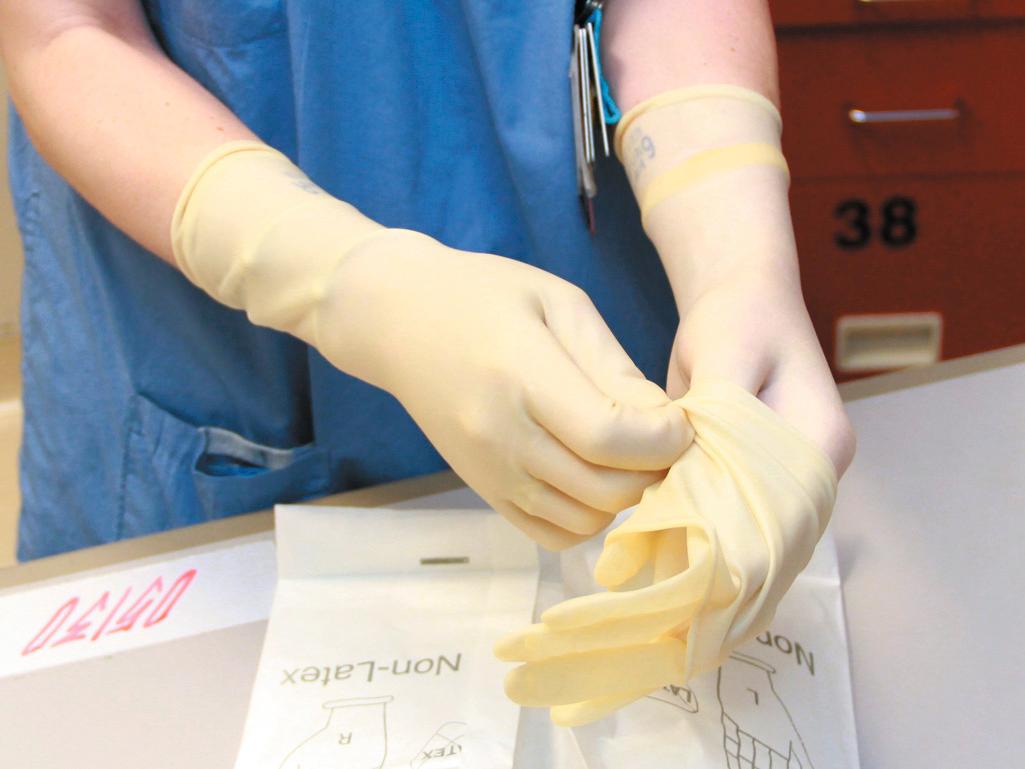
Wear a mask and protective eyewear when exposure to body fluid aerosols is possible (e.g., wound irrigation, traumatic chest wound) ( Fig. 68.2 ).
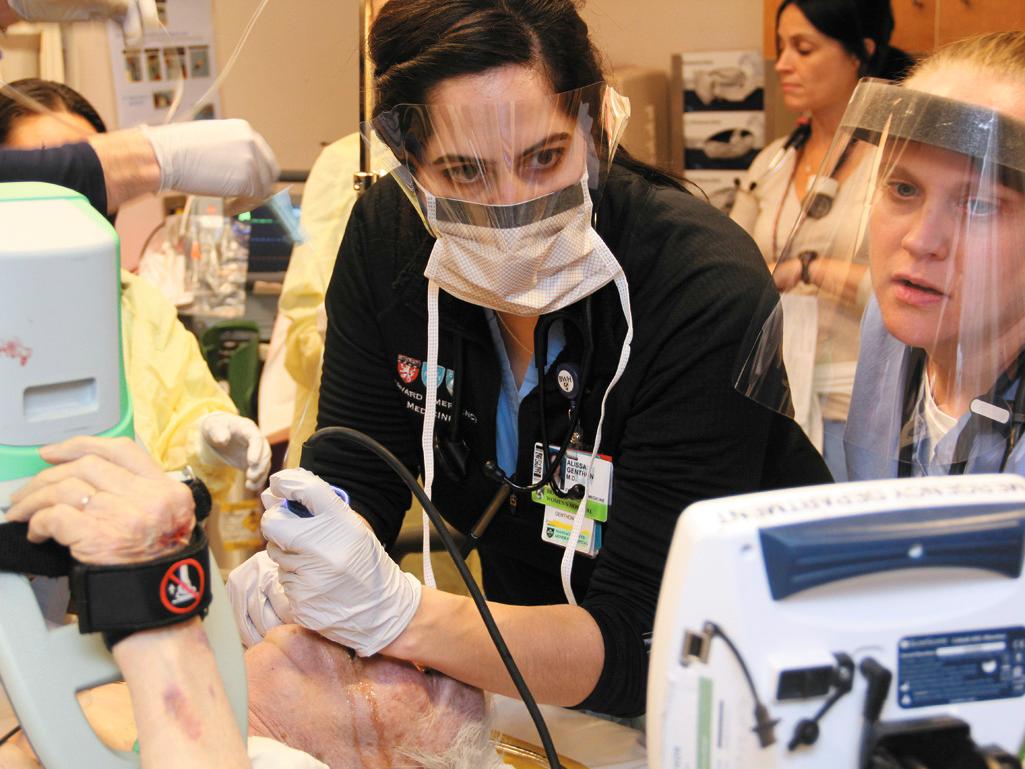
Wear a gown and shoe covers when there is a risk for large volumes of splashed body fluids (e.g., chest tube, thoracotomy) ( Fig. 68.3 ).
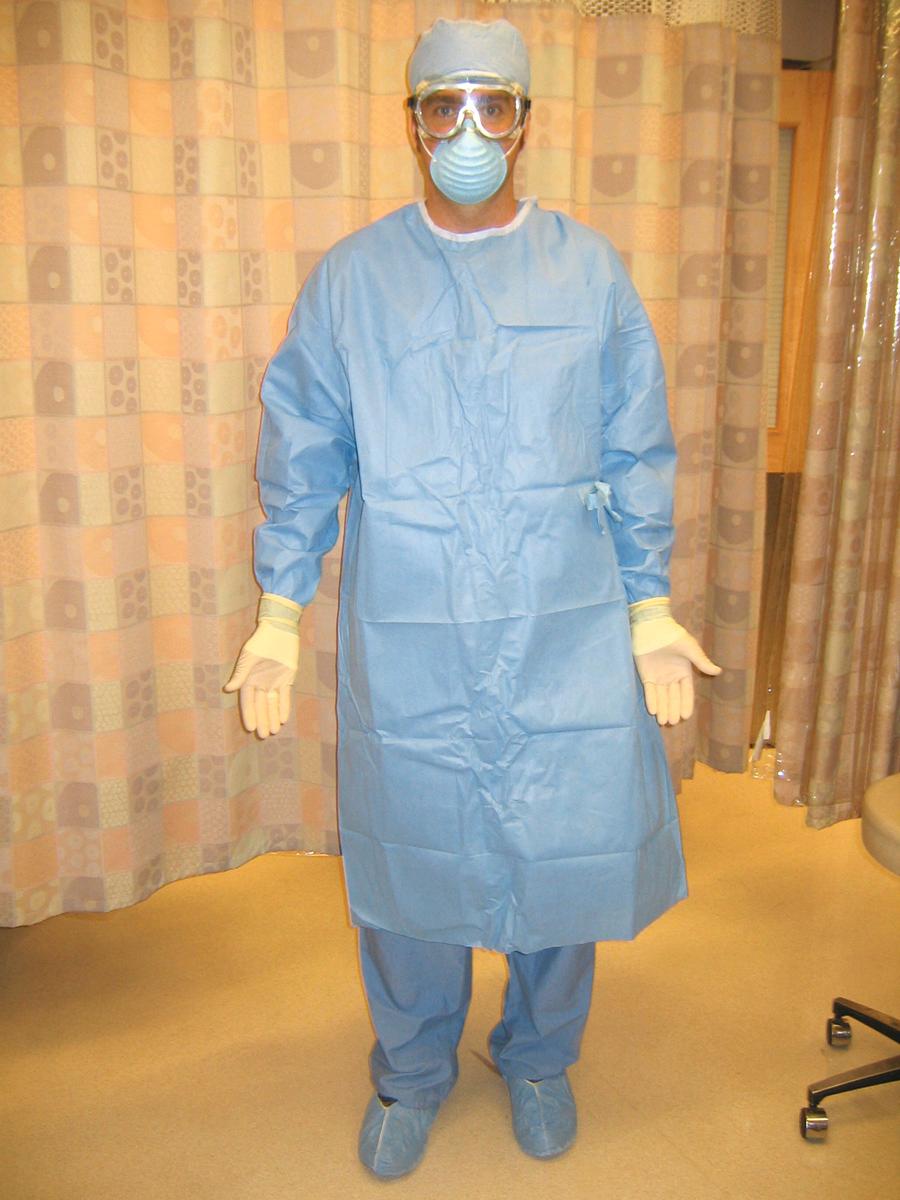
In 2007 the CDC included new elements to its standard precautions in response to outbreak investigations. The elements of “Respiratory Hygiene/Cough Etiquette” include: (1) education of health care facility staff, patients, and visitors; (2) posted signs, in language(s) appropriate to the population served, with instructions to patients and accompanying family members or friends; (3) source control measures (e.g., covering the mouth/nose with a tissue when coughing and prompt disposal of used tissues, using surgical masks on the coughing person when tolerated and appropriate); (4) hand hygiene after contact with respiratory secretions; and (5) spatial separation, ideally > 3 feet, of persons with respiratory infections in common waiting areas when possible.
Most importantly, sharps precautions mean no recapping, bending, or breaking of needles. If needle recapping is deemed necessary, use a single-handed technique ( Fig. 68.4 ). A safer alternative is to immediately dispose of the needle in an approved sharps container without recapping. In an observational study of ED employees, the rate of needle recapping was 34%, with most practitioners incorrectly using a two-handed technique. Various reengineered products are available for use in the ED, including retracting scalpels, auto-capping needles, and needleless intravenous systems ( Fig. 68.5 ). Reviews of studies looking at these safety devices have found they are associated with a reduction in needlestick injuries. US federal law now requires the use of safety-engineered sharps devices to protect HCWs. The Needlestick Safety and Prevention Act of 2000 required the use of safety-engineered sharps devices to protect HCWs from needlestick injuries. A review of data from the Exposure Prevention Information Network (EPINet) sharps injury surveillance program estimated that needlestick injuries have decreased by 34% overall, with a 51% decline in nurses since the implementation of federal legislation. To further prevent transmission of blood-borne infections, whenever possible use single-dose vials with a single-use disposable needle and syringe for each injection.

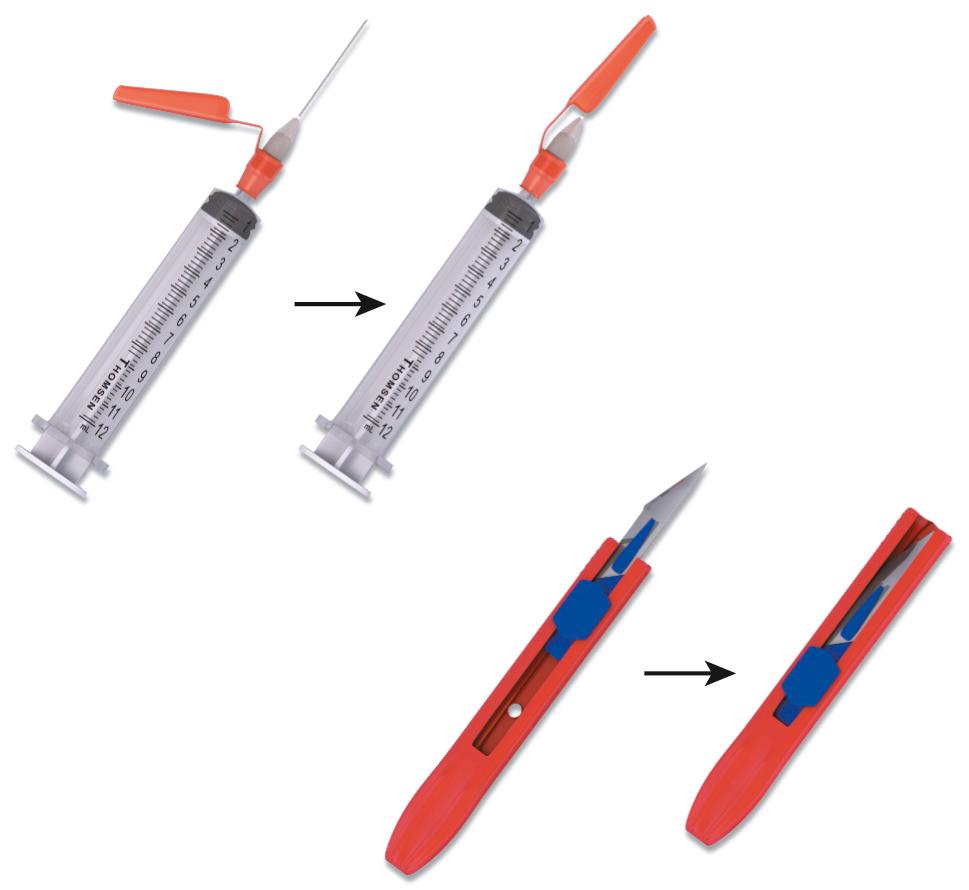
ED patients commonly present with respiratory syndromes that require respiratory precautions in addition to standard precautions ( Table 68.1 ). For example, patients with suspected or confirmed pulmonary tuberculosis (TB), rubeola virus (measles), severe acute respiratory syndrome virus (SARS), or avian influenza should be isolated with airborne precautions, plus contact precautions with eye/face protections during any aerosol-generating procedures or if any contact with respiratory secretions is anticipated. During contact with patients who require airborne precautions, wear a National Institute for Occupational Safety and Health (NIOSH)–approved N-95 particulate respirator ( Fig. 68.6 ). These masks are designed to efficiently filter 1- to 5-µm particles and are less costly and more comfortable than high-efficiency particulate air (HEPA)–filtered masks. In addition, place such patients in a respiratory isolation room with negative pressure, high circulation (optimally at least 12 air changes per hour), and external exhaust. When performing aerosol-generating procedures (such as intubation or sputum induction) that result in increased release of infectious droplets, add extra face/eye protection. However, even during outbreaks, adherence to isolation precautions is variable. A survey of medical students and residents at a Washington, DC, hospital (November–December 2009) showed that only 13% of medical students and 21% of residents would wear an N-95 respirator when caring for a patient with influenza symptoms.
| CLINICAL SYNDROME OR CONDITION b | POTENTIAL PATHOGENS c | EMPIRIC PRECAUTIONS (ALWAYS INCLUDES STANDARD PRECAUTIONS) |
|---|---|---|
| Respiratory Infections | ||
| Cough/fever/upper lobe pulmonary infiltrate in an HIV-negative patient or a patient at low risk for HIV infection. | Mycobacterium tuberculosis, respiratory viruses, Streptococcus pneumoniae, Staphylococcus aureus (MSSA or MRSA). | Airborne precautions plus contact precautions. |
| Cough/fever/pulmonary infiltrate in any lung location in an HIV-infected patient or a patient at high risk for HIV infection. | M. tuberculosis , respiratory viruses, S. pneumoniae, S. aureus (MSSA or MRSA). | Airborne precautions plus contact precautions. Use eye/face protection if aerosol-generating procedure performed or contact with respiratory secretions anticipated. If tuberculosis is unlikely and there are no AIIRs and/or respirators available, use droplet precautions instead of airborne precautions. Tuberculosis more likely in HIV-infected individual than in HIV-negative individual. |
| Cough/fever/pulmonary infiltrate in any lung location in a patient with a history of recent travel (10–21 days) to countries with active outbreaks of SARS, avian influenza. | M. tuberculosis , SARS-CoV, avian influenza | Airborne plus contact precautions plus eye protection. If SARS and tuberculosis unlikely, use droplet precautions instead of airborne precautions. |
| Respiratory infections, particularly bronchiolitis and pneumonia, in infants and young children. | Respiratory syncytial virus, parainfluenza virus, adenovirus, influenza virus, human metapneumovirus. | Contact plus droplet precautions; droplet precautions may be discontinued when adenovirus and influenza have been ruled out. |
a Infection control professionals should modify or adapt this table according to local conditions. To ensure that appropriate empiric precautions are always implemented, hospitals must have systems in place to evaluate patients routinely according to these criteria as part of their preadmission and admission care.
b Patients with the syndromes or conditions listed below may present with atypical signs or symptoms (e.g., neonates and adults with pertussis may not have paroxysmal or severe cough). The clinician's index of suspicion should be guided by the prevalence of specific conditions in the community, as well as clinical judgment.
c The organisms listed under the column “Potential Pathogens” are not intended to represent the complete, or even most likely diagnosis, but rather possible etiologic agents that require additional precautions beyond the standard precautions until they can be ruled out.
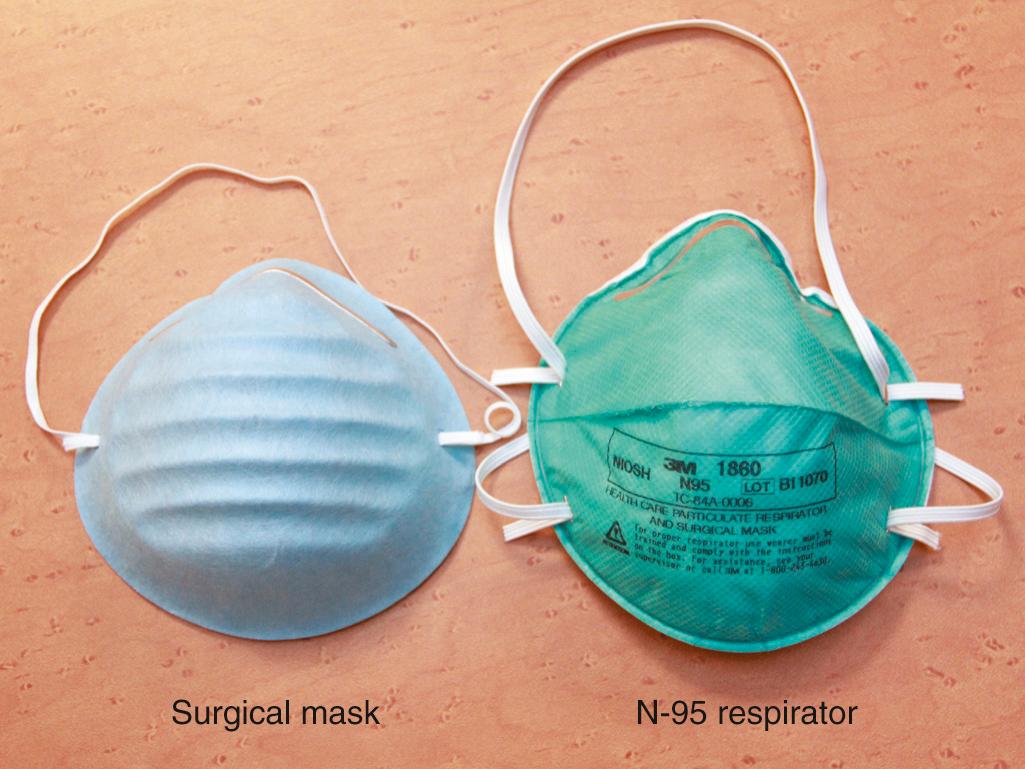
For patients with respiratory infections such as suspected or confirmed respiratory syncytial virus (RSV), parainfluenza virus, adenovirus, or human metapneumovirus, the CDC recommends droplet precautions (see Table 68.1 ). Droplet precautions consist of placing the patient in a private room or a special separation of > 3 feet. HCWs should don a mask on entering the patient's room. If transport or movement is necessary, such as to radiology, instruct the patient to wear a mask and follow Respiratory Hygiene/Cough Etiquette.
Isolation gowns are worn in combination with gloves only if contact with blood or body fluid is anticipated. The need for and the type of isolation gown selected is based on the nature of the patient interaction, including the anticipated degree of contact with infectious material and the potential for blood and body fluid penetration of the barrier. The CDC updated its personal protective equipment (PPE) guidelines when contacting haemorrhagic fever viruses in response to new data gained during an outbreak of the Ebola virus in several West African nations. CDC guidance emphasizes the importance of training, practice, competence, and observation of HCWs in correct donning and doffing of PPE. Procedures recommended by the CDC for donning and doffing PPE are aimed at preventing skin or clothing contamination and are shown in Figs. 68.7 and 68.8 .
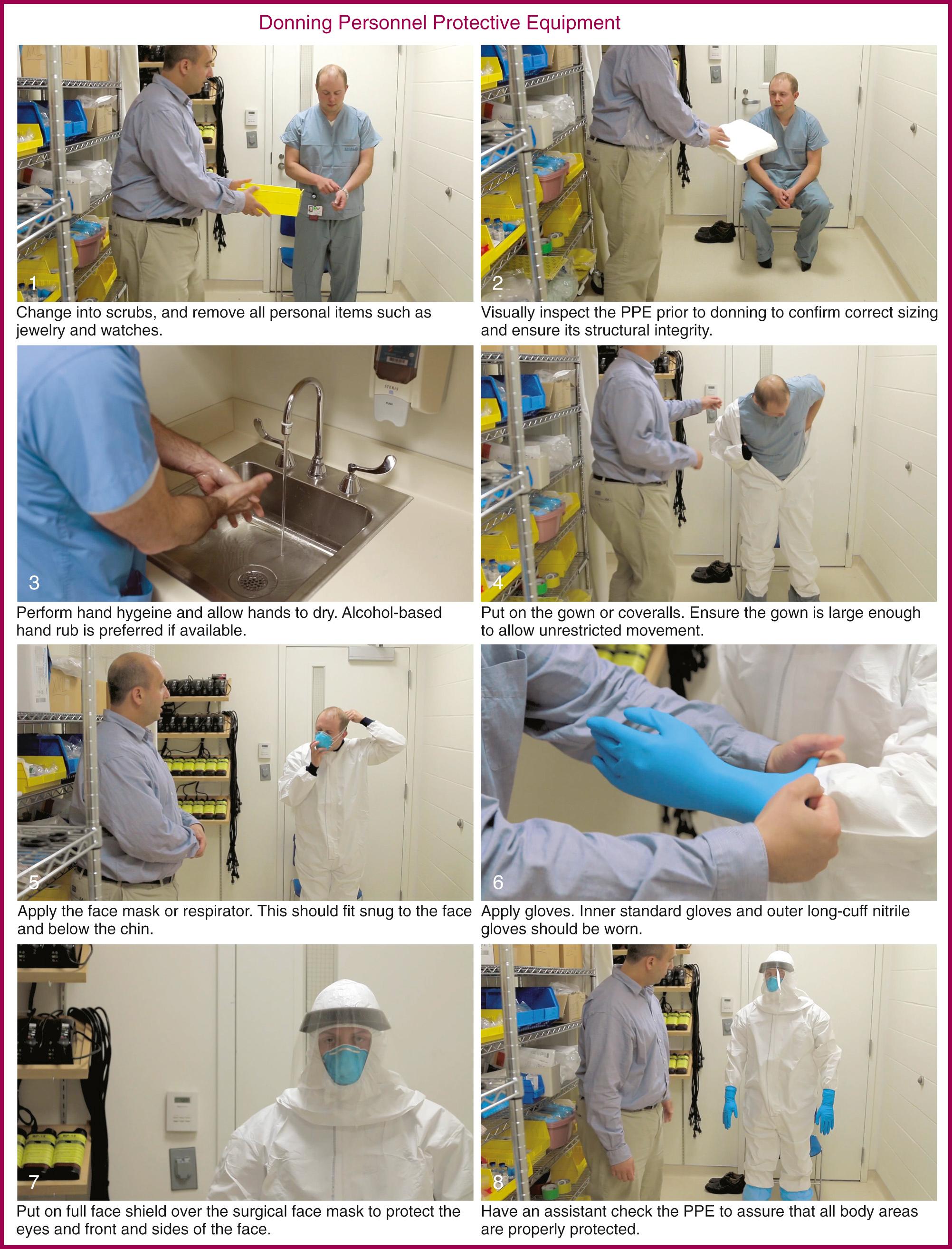
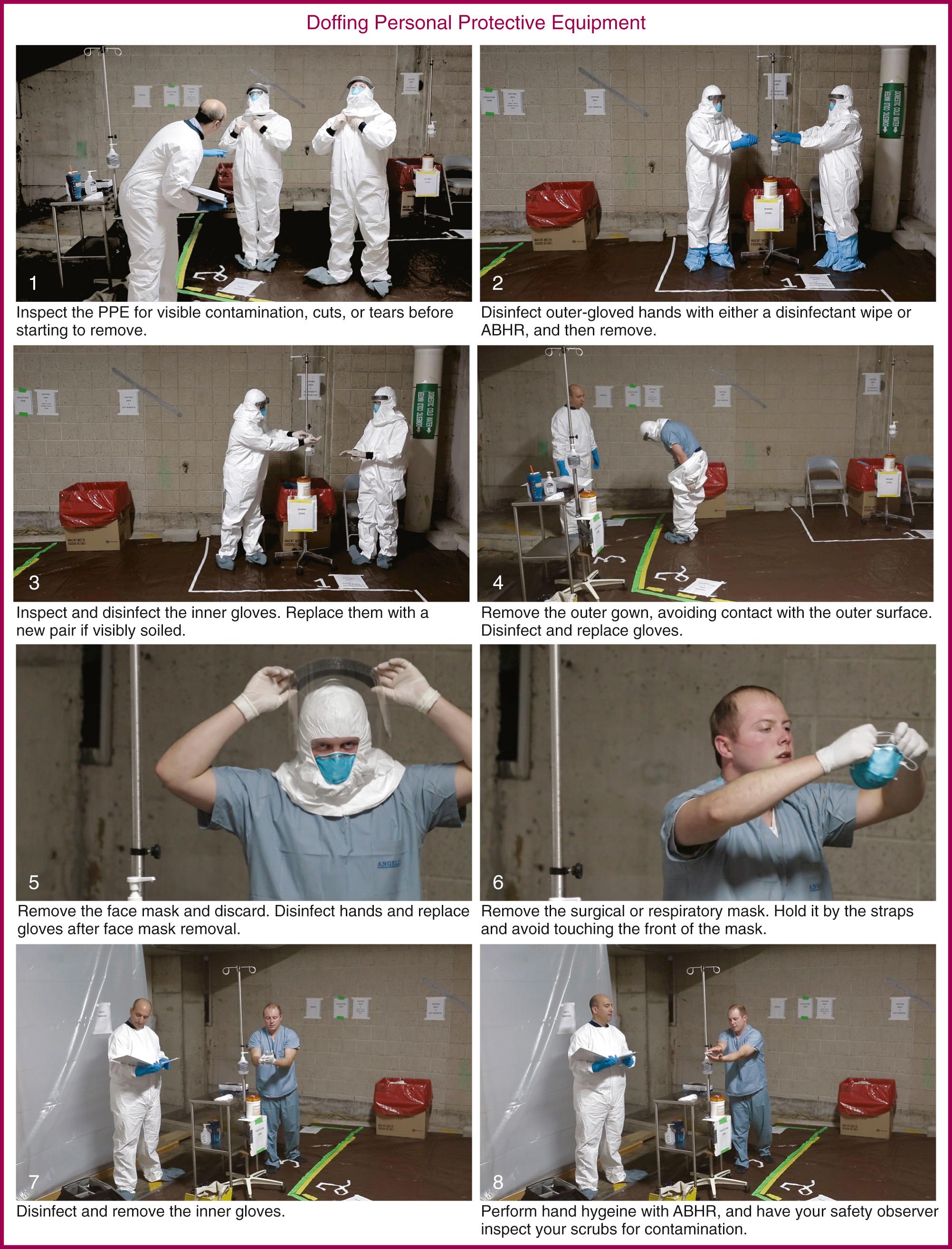
Contamination during removal of PPE occurs frequently, thus training and practice are important to reduce the risk of contamination during PPE removal.
The CDC recommends the following sequence for donning and doffing PPE when evaluating persons under investigation for Ebola.
This donning procedure applies to PPE recommended for evaluating and managing persons under investigation, who are clinically stable and do not have bleeding, vomiting, or diarrhea. There is a lower risk of splashes and contamination in these situations. An established protocol, combined with proper training of the HCW, helps to facilitate compliance with PPE guidance.
Remove personal clothing and items. The HCW should wear surgical scrubs. No personal items (e.g., jewelry [including rings], watches, cell phones, pagers, pens) should be worn under PPE or brought into the patient room. Long hair should be tied back. Eyeglasses should be secured with a tie.
Inspect PPE prior to donning. Visually inspect the PPE ensemble to ensure that it is in serviceable condition (e.g., not torn or ripped), that all required PPE and supplies are available, and that the sizes selected are correct for the HCW.
Perform hand hygiene. Perform hand hygiene with alcohol-based hand rub (ABHR). When using ABHR, allow hands to dry before moving to the next step.
Put on inner gloves. Put on first pair of gloves.
Put on gown or coverall. Ensure gown or coverall is large enough to allow unrestricted movement. Ensure cuffs of inner gloves are tucked under the sleeve of the gown or coverall.
Put on face mask.
Put on outer gloves. Put on second pair of gloves (with extended cuffs). Ensure the cuffs are pulled over the sleeves of the gown or coverall.
Put on face shield. Put on full face shield over the surgical face mask to protect the eyes, as well as the front and sides of the face.
Verify. After completing the donning process, the integrity of the ensemble should be verified by the HCW (e.g., there should be no cuts or tears in the PPE). The HCW should be comfortable and able to extend the arms, bend at the waist, and go through a range of motions to ensure there is sufficient range of movement while all areas of the body remain covered. A mirror in the room can be useful for the HCW while donning PPE.
PPE is doffed in the designated PPE removal area in the health care facility. As with all PPE doffing, meticulous care should be taken to avoid self-contamination. Place all PPE waste in a leak-proof infectious waste container.
Inspect. Inspect the PPE for visible contamination, cuts, or tears before starting to remove. If any PPE is visibly contaminated, disinfect by using an Environmental Protection Agency (EPA)-registered disinfectant wipe. If the facility conditions permit and appropriate regulations are followed, an EPA-registered disinfectant spray can be used, particularly on contaminated areas.
Disinfect and remove outer gloves. Disinfect outer-gloved hands with either an EPA-registered disinfectant wipe or ABHR. Remove and discard outer gloves, taking care not to contaminate inner gloves when removing the outer gloves. Dispose of outer gloves into the designated leak-proof infectious waste container.
Inspect and disinfect inner gloves. Inspect the inner gloves' outer surfaces for visible contamination, cuts, or tears. If an inner glove is visibly soiled, disinfect the glove with either an EPA-registered disinfectant wipe or ABHR, remove the inner gloves, perform hand hygiene with ABHR on bare hands, and don a new pair of gloves. If a cut or tear is seen on an inner glove, immediately review occupational exposure risk per hospital protocol. If there is no visible contamination and no cuts or tears on the inner gloves, then disinfect the inner-gloved hands with either an EPA-registered disinfectant wipe or ABHR.
Remove face shield. Remove the full face shield by tilting the head slightly forward, grabbing the rear strap and pulling it over the head, gently allowing the face shield to fall forward. Avoid touching the front surface of the face shield. Discard the face shield into the designated leak-proof infectious waste container.
Disinfect inner gloves. Disinfect inner gloves with either an EPA-registered disinfectant wipe or ABHR.
Remove gown or coverall. Remove and discard.
Depending on the gown design and location of fasteners, the HCW can either untie or gently break fasteners. Avoid contact of scrubs or disposable garments with the outer surface of the gown during removal. Pull the gown away from the body, rolling it inside out and touching only the inside of the gown.
To remove the coverall, tilt the head back to reach zipper or fasteners. Unzip or unfasten the coverall completely before rolling down while turning inside out. Avoid contact of scrubs with outer surface of coverall during removal, touching only the inside of the coverall. Dispose of gown or coverall into the designated leak-proof infectious waste container.
Disinfect and change inner gloves. Disinfect inner gloves with either an EPA-registered disinfectant wipe or ABHR.
Remove and discard gloves, taking care not to contaminate bare hands during the removal process.
Perform hand hygiene with ABHR.
Don a new pair of inner gloves.
Remove surgical face mask. Remove the surgical face mask by tilting the head slightly forward, grasping first the bottom tie or elastic strap, then the top tie or elastic strap, and remove the front of the surgical face mask without touching it. Discard the surgical face mask into the designated leak-proof infectious waste container.
Disinfect and remove inner gloves. Disinfect inner-gloved hands with either an EPA-registered disinfectant wipe or ABHR. Remove and discard gloves, taking care not to contaminate bare hands during the removal process. Dispose of inner gloves into the designated leak-proof infectious waste container.
Perform hand hygiene. Perform hand hygiene with ABHR.
Inspect. The HCW should inspect for any contamination of the surgical scrubs or disposable garments. If there is contamination, shower immediately, and then immediately inform the infection preventionist, occupational safety and health coordinator, or their designee.
Become a Clinical Tree membership for Full access and enjoy Unlimited articles
If you are a member. Log in here